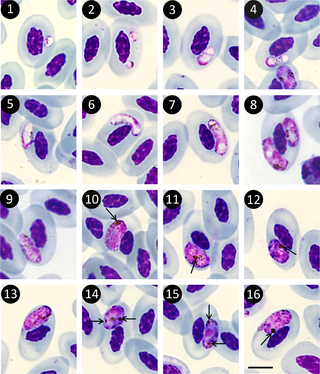
Plasmodium is a genus of unicellular eukaryotes that are obligate parasites of vertebrates and insects. The life cycles of Plasmodium species involve development in a blood-feeding insect host which then injects parasites into a vertebrate host during a blood meal. Parasites grow within a vertebrate body tissue before entering the bloodstream to infect red blood cells. The ensuing destruction of host red blood cells can result in malaria. During this infection, some parasites are picked up by a blood-feeding insect, continuing the life cycle.

The Plasmodiidae are a family of apicomplexan parasites, including the type genus Plasmodium, which is responsible for malaria. This family was erected in 1903 by Mesnil and is one of the four families in the order Haemospororida.
Giovanolaia is a subgenus of the genus Plasmodium created by Corradetti et al. in 1963. The parasites within this subgenus infect birds.
Haemamoeba is a subgenus of the genus Plasmodium — all of which are parasites. The subgenus was created in 1963 by created by Corradetti et al.. Species in this subgenus infect birds.
Vinckeia is a subgenus of the genus Plasmodium — all of which are parasitic alveolates. The subgenus Vinckeia was created by Cyril Garnham in 1964 to accommodate the mammalian parasites other than those infecting the primates.
Plasmodium minasense is a parasite of the genus Plasmodium subgenus Carinamoeba.
Plasmodium anasum is a species of the genus Plasmodium.
Plasmodium cephalophi is a parasite of the genus Plasmodium subgenus Vinckeia. As in all Plasmodium species, P. cephalophi has both vertebrate and insect hosts. The vertebrate hosts for this parasite are mammals.
Plasmodium volans is a parasite of the genus Plasmodium subgenus Carinamoeba.
Sauramoeba is a subgenus of the genus Plasmodium, all of which are parasitic eukaryotes. The subgenus was created in 1966 by Garnham. Species in this subgenus infect reptiles.
Plasmodium lygosomae is a parasite of the genus Plasmodium subgenus Carinamoeba.
Plasmodium marginatum is a parasite of the genus Plasmodium subgenus Sauramoeba. As in all Plasmodium species, P. marginatum has both vertebrate and insect hosts. The vertebrate hosts for this parasite are reptiles.
Plasmodium basilisci is a parasite of the genus Plasmodium subgenus Carinamoeba.
Plasmodium clelandi is a parasite of the genus Plasmodium subgenus Carinamoeba.
Plasmodium diminutivum is a parasite of the genus Plasmodium subgenus Carinamoeba.
Plasmodium uluguruense is a parasite of the genus Plasmodium subgenus Lacertamoeba.
Plasmodium loveridgei is a parasite of the genus Plasmodium subgenus Lacertamoeba.

The Haemosporida are an order of intraerythrocytic parasitic alveolates.
Plasmodium mabuiae is a parasite of the genus Plasmodium subgenus Carinamoeba.


